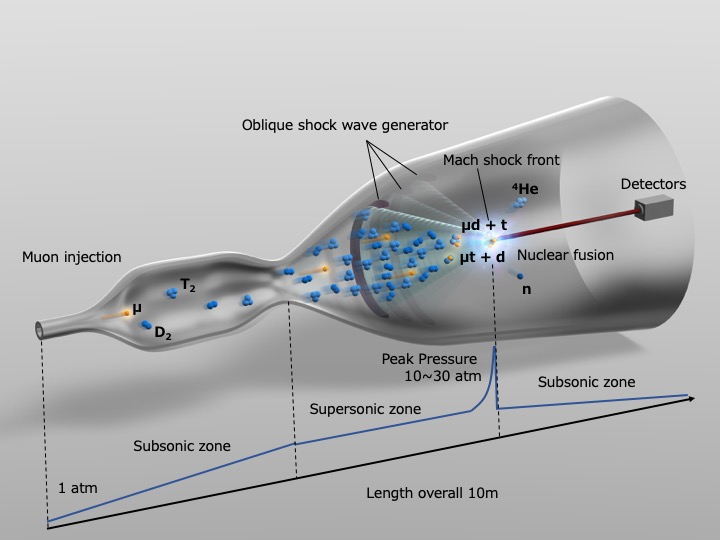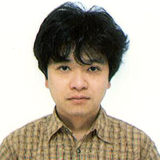| Program B02 | Basic research of in-flight muon catalyzed fusion in the Mach shock wave interference region |
|---|---|
| Principal Investigator | KINO, Yasushi (Tohoku University) |
When a muon (μ) binds a deuteron (d) and a triton
(t) to make a muonic molecule (dtμ), nuclear fusion
reaction d + t → 4He + n + 17.6
MeV occurs in the muonic molecule. After the nucrear fusion reaction,
the muon forms another dtμ molecule and causes a nuclear
fusion reaction, again. This phenomenon that the muon successively
induces the nuclear fusion reaction. This series of processes is
called "muon catalyzed fusion (μCF). The μCF was expected to be
a future energy source, and so far a lot of research had been
attempted. However, there was a problem that the energy obtained by
the μCF has not reached the equivalent energy to create a
muon.
In the present project, we propose new ideas that will be a
break-through of μCF, and verify their feasibility. In the
conventional μCF, there are rate-limiting processes such as muon
transfer and muon molecular formation processes at cryogenic
temperature. In order to avoid these rate-limiting process, we adopt
a new process of the nuclear fusion reaction which occurs during a
muon atomic collision at high temperature (dμ + t
→ 4He + n + μ + 17.6 MeV and dμ
+ t → 4He + n + μ + 17.6 MeV). If
the target is sufficiently heated by the nuclear fusion energy, the
muon can also induced nuclear fusion reaction succesively. This
mechanism can be called in-flight muon catalyzed fusion
(IFμCF). To verify the IFμCF, we will study muon atomic
processes including nuclear reaction from both theoretical and
experimental point of view.
In the theoretical study, we develop a “non-adiabatic coupled
rearrangement channel method” based on a rigorous quantum few
body theory, and perform precise calculation incorporating the
degrees of freedom of both nuclei and muonic atoms/molecules. In
addition to the nuclear fusion reaction cross section of IFμCF,
calculate various muon atomic processes related to the experiment by
using supercomputer. In addition, since this theoretical method is a
high versatility method that does not use any approximation depending
on constituent particles of the system, it can be applied to other
theoretical problems in the Scientific Research on Innovative
Areas.

Figure: Muon target including Mach shock wave interference
region. Deuterium and tritium gas mixture flows at high speed
from left to right. Pressure in the tube sharply increases in the
Mach shock wave interference region, creating high density
region. Injected muons stop in this high density region and form
muonic atoms, causing in flight muon catalytic fusion (IF μCF)
via muon atomic collisions.
In the experimental study, we develop a new muon target including
Mach shock wave interference region (Figure) in order to realize
IFμCF. This target applies supersonic airflow of the deuterium and
tritium gas mixture to the shock wave generator. The superposition of
the shock waves creates a metastable and high density interference
region. The advantage of this device is that the pressure in the
container is around 1 atm except for the interference region, so we
can place detectors to monitor the reaction relatively freely. By
circulating the gas, He particles and thermal energy generated by the
nuclear fusion reaction can be efficiently collected. Compareing with
the few-body theory, we analyze the muon atomic processes in the
IFμCF measured by state-of-the-art detectors developed in the
Scientific Research on Innovative Areas.
Members
| Principal Investigator | KINO, Yasushi (Graduate School of Science, Tohoku University) |
 |
|---|---|---|
| Co-Investigator | SATO, Motoyasu (Chubu University) | |
| TANAHASHI, Yoshiharu (Chubu University) | ||
| YAMAMOTO, Norimasa (Chubu University) | ||
| OKADA, Shinji (Chubu University) | ||
| OKA, Toshitaka (Japan Atomic Energy Agency (JAEA)) | ||
| Research Collaborators | OKUTSU, Kenichi (Gakushuin University) | |
| KUDO, Hiroshi (Tohoku University) | ||
| NAKAMURA, Satoshi N. (The University of Tokyo) | ||
| YAMASHITA, Takuma (Tohoku University) | ||
| MUTO, Takashi (Chubu University) | ||
| HIROOKA, Yoshihiko (Chubu University) | ||
| MATSUBARA, Akihiro (Chubu University) | ||
| TAKANO, Hirohisa (Chubu University) | ||
| ITOH, Kimitaka (Chubu University) | ||
| AZUMA, Toshiyuki (RIKEN) | ||
| KAWAMURA, Naritoshi (KEK) | ||
| MATOBA, Shiro (KEK) | ||
| HIYAMA, Emiko (Tohoku University) | ||
| NOMACHI, Masaharu (Osaka University) |
Reference Materials
- T. Yamashita, M. Umair, Y. Kino, “Bound and resonance states of positronic copper atoms,” J. Phys. B: At. Mol. Opt. Phys. 50, 205002 (2017), DOI: 10.1088/1361-6455/aa8b3b .
- H. A. Sakaue, D. Kato, N. Yamamoto, N. Nakamura, and I. Murakami, “Spectra of W19+-W32+ observed in the EUV region between 15 and 55 Å with an electron beam ion trap,” Phys. Rev. A 92, 012504 (2015), DOI: 10.1103/PhysRevA.92.012504 .
- H. Yokoe, T. Sugimura, Y. Tanahashi, “Numerical simulation on interaction of a detonation wave with a shock wave using detailed chemical reaction,” J. Jpn Soc. Fluid Mech. NAGARE 34, 157–165 (2015), http://id.nii.ac.jp/1141/00377498/ .
- M. Sato, J. Fukushima, S. Takayama, “An explanation of microwave effects by expansion of transit state theories with disturbed velocity, distributions by microwave,” Am. Ceram. Soc. Ceram. Transact. MS&T 13, 1 (2013).
- E. Hiyama, Y. Kino, M. Kamimura, “Gaussian expansion method for few-body systems,” Prog. Part. Nucl. Phys. 51, 223–307 (2003), DOI: 10.1016/S0146-6410(03)90015-9 .
